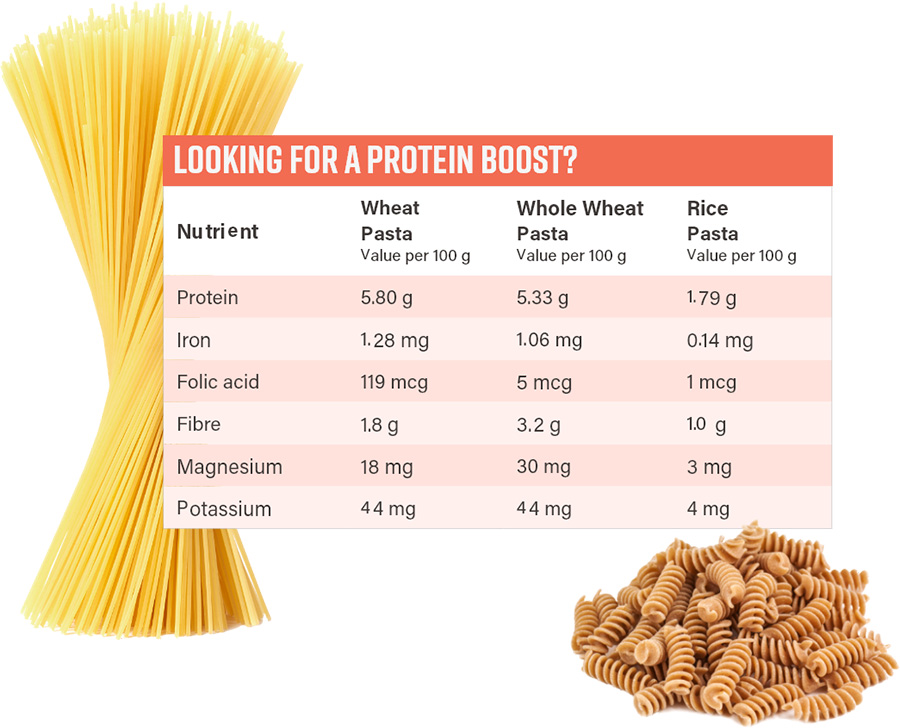What About
Gluten?
Gluten is a natural plant protein present in wheat, rye, and barley. Its unique functional properties
play a role in the texture and structure of foods like bread, pasta, and baked goods.

Gluten is a natural plant protein present in wheat, rye, and barley. Its unique functional properties
play a role in the texture and structure of foods like bread, pasta, and baked goods.
When water is added to wheat flour, two plant proteins, gliadin and glutenin, combine to form gluten. Gluten works like an elastic net that stretches to trap air bubbles in the dough. This contributes to the signature texture of bread and the light, fluffy cakes we enjoy. In pasta, gluten helps provide the shape and structure of the pasta while lowering its glycemic index.
Because of it’s great versatility, wheat is a common ingredient and gluten is found everywhere wheat is present.

Research suggests that gluten-free diets can be lower in dietary fibre and micronutrients including vitamin D, vitamin B12, folic acid, calcium and magnesium due to the avoidance of several foods naturally rich in fibre like grains1. This means individuals following a gluten-free diet should work with a registered dietitian to ensure they aren’t missing out on key nutrients in their diet.

Gluten-free food products are extremely important for people who need to avoid gluten or wheat, but they don’t always stack up nutritionally. In Canada refined wheat flour, (‘all-purpose flour’), and the products made with it, are required to be fortified and enriched with important vitamins and minerals. Gluten-free substitutions made with rice or other grains do not have this requirement. Because of this, gluten-free foods such as bread, cereals, flours and pastas may have less iron, folic acid2, protein and fibre3, so it’s important to check the label carefully.
Celiac disease is an autoimmune disorder where the body mounts an immune response to attack the small intestine when foods containing gluten are consumed. This results in symptoms such as diarrhea, abdominal pain, weight loss and malabsorption of nutrients. Celiac disease is diagnosed through an antibody blood test often followed by a biopsy of the small intestine. It is estimated that 1% of the population4 is affected by celiac disease.
Similar to a peanut or other food allergy, a wheat allergy is a serious condition in which an immune response occurs after consuming wheat proteins. It includes symptoms such as swelling of the mouth, hives, difficulty breathing and anaphylaxis, requiring immediate medical attention. It is not related to celiac disease or non-celiac gluten sensitivity. It is estimated that 0.3 – 0.4% of the population5 has a wheat allergy.

Non-celiac gluten sensitivity (NCGS) or intolerance, is a condition where a person may test negative for celiac disease, but still experiences symptoms such as bloating, excess gas, abdominal pain, diarrhea, headache and a runny nose after consuming products containing gluten. These symptoms can occur hours or days after ingestion, and severity is determined by the amounts of food eaten. There is currently no accepted method to confirm a diagnosis of NCGS. As it is often self-diagnosed, the prevalence is unknown.
1 https://pubmed.ncbi.nlm.nih.gov/27211234/
2 https://pubmed.ncbi.nlm.nih.gov/27211234/
3 https://pubmed.ncbi.nlm.nih.gov/17625125/
4 Health Canada 2018; Jamnik et al. 2017
5 Canadian food allergy prevalence. Hamilton (ON): AllerGen, Michael DeGroote Centre for Learning and Discovery, McMaster University; 2017

Gluten is a protein found naturally in wheat. Its functional properties provide the necessary structure to foods like bread, pasta and baked goods.
Celiac disease and wheat allergies are critical health issues. People diagnosed with these conditions should avoid consumption of foods made with wheat.
For those without a medical reason to avoid wheat-based foods or gluten, there may be unintended dietary impacts such as lower intake of dietary fibre and key vitamins and minerals.
Gluten is a plant protein that is formed when two protein fractions, gliadin and glutenin, combine when water is added to ground wheat or flour and mixing occurs. Both gliadin and glutenin have unique properties; gliadin provides extensibility and glutenin provides elasticity.
If it seems like there is gluten in everything, it’s because wheat is a common ingredient in breads, baked goods, pastas, and cereals. It’s also in beer and malt vinegar and used for thickening sauces. Gluten is found everywhere that wheat is present.
Celiac disease is a serious autoimmune disorder where the surface of the small intestines that absorb nutrients is damaged by the ingestion of gluten.
When people with celiac disease eat gluten, their body mounts an immune response to attack the small intestine (which is where the gluten is being absorbed by the body). These attacks are what lead to damage of the small intestine. This results in symptoms such as:
Other symptoms of celiac disease include anemia, fatigue, oral ulcers, and constipation. Although well-known, celiac disease is thought to affect about 1% of the population.
This autoimmune disease has a genetic component and is hereditary, meaning it can be common in families and can be diagnosed at any age.
Diagnosis is most commonly achieved through a blood test that looks for antibodies (IgA anti-tissue transglutaminase) followed by a biopsy of the small intestine to confirm the diagnosis. Genetic testing can be helpful to help rule out celiac disease.
There is no cure for celiac disease so strict adherence to a gluten-free diet and nutritional management by a knowledgeable professional is necessary.
For more information and resources about celiac disease, please visit the Canadian Celiac Association here.
Dermatitis herpetiformis is referred to as ‘celiac disease of the skin’ because it presents as a skin rash with intense itching and burning after the ingestion of gluten. This is an uncommon disorder affecting about 10 people per 100,000 (or 0.0001% of the population). It typically presents later in life, in people over the age of 40.
Many factors may contribute such as genetics and the immune system, but the precise biological mechanisms remain unknown.
Often appearing as symmetrical rashes (on elbows, knees) this rash is diagnosed with a skin biopsy.
Similar to a peanut or other food allergy, a wheat allergy is a serious condition in which an immune response occurs after consuming wheat proteins. It includes symptoms such as swelling of the mouth, hives, difficulty breathing, and anaphylaxis, requiring immediate medical attention. It is not related to celiac disease or non-celiac gluten sensitivity.
Non-celiac gluten sensitivity (NCGS), also called gluten intolerance or sensitivity, is a condition where an individual may test negative for celiac disease or a wheat allergy, but still experience symptoms such as bloating, excess gas, abdominal pain, diarrhea, headache and a runny nose after consuming products containing gluten. These symptoms can occur hours or days after ingesting gluten, and severity is determined by the amounts of food eaten.
Celiac disease and gluten sensitivity both cause gastrointestinal symptoms, so before gluten sensitivity can be diagnosed, it’s important to first rule out celiac disease.
There is currently no accepted method of confirming a diagnosis of NCGS by using tests or looking for markers in our body (such as compounds in our blood or urine). As it is often self-diagnosed, the prevalence is unknown. Recent studies are mixed when determining the prevalence of NCGS, with estimates ranging from less than that of celiac disease to upwards of 10% of the population.
Treating gluten sensitivity also requires a gluten-free diet; however, there may be more flexibility in this diet compared to someone with celiac disease because of the less severe symptoms and damage to the intestines.
This condition is relatively new and poorly understood as more research is required to determine the cause, mechanism, diagnosis methods, and management of the symptoms.
It’s important to note that NCGS also overlaps with fructose malabsorption. For many individuals, removing fructose and fructo-oligosaccharides from the diet is a successful treatment.

According to consumer surveys, Canadians believe gluten-free foods are healthier than gluten-containing foods and about 25% of consumers purchase gluten-free foods with the purpose of managing their weight. In fact, unless medically necessary, avoiding gluten-containing foods means individuals may miss out on the benefits of fibre and micronutrients including vitamin D, vitamin B12, folate, calcium, and magnesium.
Gluten-free food products are extremely important for people who need to avoid gluten or wheat, but they don’t always stack up nutritionally. Many products made with wheat are fortified and enriched with important vitamins and minerals you need in your diet, but gluten-free substitutions made with rice or other grains may not be fortified or enriched with any additional vitamins and minerals.
In Canada, gluten-free staple foods such as bread, cereals, flours, and pastas can have less iron, folate, protein, and fibre, so it’s important to check the label carefully. You can read more about the benefits of fortification and enrichment here.
Some individuals without celiac disease have reported improvement in digestive symptoms following a gluten-free diet, which can give the impression that they have a gluten sensitivity or intolerance. However, this improvement could be due to the addition of high-quality, nutrient-dense foods in their diet such as an increased intake of fruits and vegetables to replace lower-quality food choices.
Research suggests that gluten-free diets can be lower in fibre and micronutrients including vitamin D, vitamin B12, folate, calcium, and magnesium due to the avoidance of several foods naturally rich in fibre like grains.